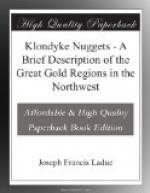“In our own time, after the intercourse that there has been between them and the whites, more than a suspicion of such unknown, cruel people lurks in the minds of many of the Indians. It would be futile for me to try to ascribe an origin for these fears, my knowledge of their language and idiosyncrasies being so limited.
“Nothing more was ever done in the vicinity of Fort Selkirk[7] by the Hudson’s Bay Company after these events, and in 1869 the Company was ordered by Capt. Charles W. Raymond, who represented the United States Government, to evacuate the post at Fort Yukon, he having found that it was west of the 141st meridian. The post was occupied by the Company, however, for some time after the receipt of this order, and until Rampart House was built, which was intended to be on British territory, and to take the trade previously done at Fort Yukon.
[Footnote 7: This is now a winter port for steamboats of the North American Transportation and Trading Company, plying the Yukon and its tributaries. There is also a trading post here owned by Harper & Ladue.]
“Under present conditions the Company cannot very well compete with the Alaska Commercial Company, whose agents do the only trade in the district,[8] and they appear to have abandoned—for the present at least—all attempt to do any trade nearer to it than Rampart House to which point, notwithstanding the distance and difficulties in the way, many of the Indians on the Yukon make a trip every two or three years to procure goods in exchange for their furs. The clothing and blankets brought in by the Hudson’s Bay Company they claim are much better than those traded on their own river by the Americans. Those of them that I saw who had any English blankets exhibited them with pride, and exclaimed ‘good,’ They point to an American blanket in contempt, with the remark ‘no good,’ and speak of their clothing in the same way.
[Footnote 8: Since the date of this report the North American Transportation and Trading Company, better known in the Yukon valley as “Captain Healy’s Company,” has established a number of posts on the river.]
“On many maps of Alaska a place named ‘Reed’s House’ is shown on or near the upper waters of Stewart River. I made enquiries of all whom I thought likely to know anything concerning this post, but failed to elicit any information showing that there ever had been such a place. I enquired of Mr. Reid, who was in the Company’s service with Mr. Campbell at Fort Selkirk, and after whom I thought, possibly, the place had been called, but he told me he knew of no such post, but that there was a small lake at some distance in a northerly direction from Fort Selkirk, where fish were procured. A sort of shelter had been made at that point for the fishermen, and a few furs might have been obtained there, but it was never regarded as a trading post.




